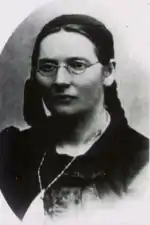Guðrún Björnsdóttir
Guðrún Björnsdóttir (27 November 1853 – 11 September 1936) was an Icelandic politician and women's rights activist. She was a founder of the Icelandic Women's Rights Association and one of the first female members of the Reykjavík City Council.
Guðrún Björnsdóttir | |
|---|---|
 | |
| Member of the Reykjavík City Council | |
| In office 1908–1914 | |
| Personal details | |
| Born | 27 November 1853 Eyjólfsstaðir, Iceland |
| Died | 11 September 1936 (aged 82) Reykjavík, Iceland |
Early life and family
Guðrún Björnsdóttir was born at Eyjólfsstaðir on 27 November 1853 where she lived until the age of 10 when her father died.[1][2][3] She was then sent to Eskifjörður for foster care, but soon moved to Langanes to live with her uncle.[1][3] For a brief period she lived in Copenhagen, but after a while returned to her relatives in Langanes.[1]
In 1884, she married pastor Lárus Jóhannesson, and in Sauðanes they raised four daughters.[1][2] After only four years of marriage, Guðrún's husband died.[1][3] One of her daughters would go on to die in the Spanish flu.[2]
Guðrún stayed with her brother in Norður-Þingeyjarsýsla until she moved with her daughters to Reykjavík in 1900 where she became a milk vendor.[1][4] She also began writing articles in the papers about milk sales and personal hygiene.[3][4]
Political career
Guðrún was prominent in the local women's rights movement in the early 20th century and was a founder of the Icelandic Women's Rights Association. She was one of the first women elected to the Reykjavík City Council.[5][6] Alongside her in City Council were three other newly elected women; Bríet Bjarnhéðinsdóttir, Þórunn Jónassen, and Katrín Magnússon.[5][6]
Guðrún sat in the town council in 1908 to 1914,[1][4] focused on health and educational issues.[2] In particular, she promoted women's education and their right to hold office. She helped towards establishing a Women's Student Scholarship Fund.[2]
Death and legacy
Guðrún died in Reykjavík on 11 September 1936.[2] A memorial about her, which appeared in Morgunblaðið on 18 September 1936, wrote about her:
The death of Mrs. Guðrún marks the passing of a woman who was an old style grand lady and an early pioneer for the new women rights for the country.[2][lower-alpha 1]
In November 2010, the Reykjavík City Council announced that a street in the city, would be renamed Guðrúnartún in honor of Guðrún Björnsdóttir.[7]
Notes
- Icelandic Með frú Guðrúnu er fallin í valinn kona, sem var í senn stórbrotin kona í gömlum stíl og ein af brautreyðjendum hinna nýju kvenrjettinda í landinu.
References
- "Guðrún Björnsdóttir". Kvennasögusafn Íslands (in Icelandic). Retrieved 10 July 2019.
- "Minningarorð um frú Guðrúnu Björnsdóttur". Morgunblaðið (in Icelandic). 18 September 1936. p. 7. Retrieved 10 July 2019.
- Gíslason, Þorsteinn, ed. (1 May 1908). "Konur i bæjarstjórn Reykjavikur" [Women in Reykjavik City Council]. Óðinn (in Icelandic). Reykjavík: Prentsmiðjan Gutenberg. 4 (2): 13. Retrieved 10 July 2019 – via timarit.is.
- "Guðrún Björnsdóttir". Konur og stjórnmál. Retrieved 10 July 2019.
- Auður Styrkársdóttir (2 February 2008). "Vel byrjar það!". Lesbók Morgunblaðsins (in Icelandic). p. 2. ISSN 1670-3898. Gegnir: 000447333. Retrieved 6 August 2019 – via timarit.is.
- "Atburðir". Konur og stjórnmál. Retrieved 10 July 2019.
- "Kvenskörungarnir fá nöfnin sín á göturnar þrátt fyrir hörð mótmæli íbúa og fyrirtækja". Pressan (in Icelandic). 26 November 2010. Archived from the original on 26 November 2010. Retrieved 10 July 2019.